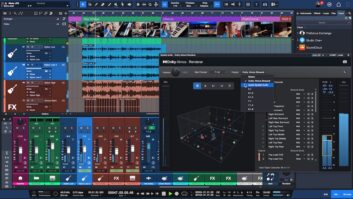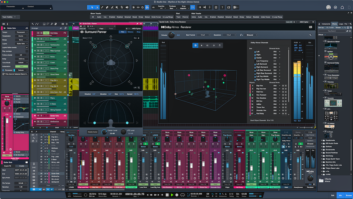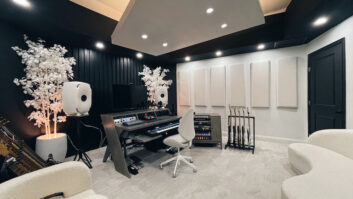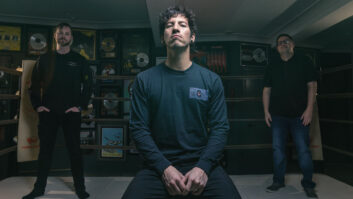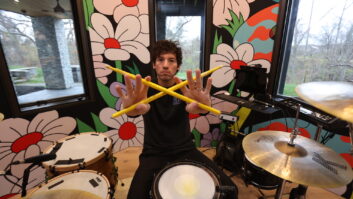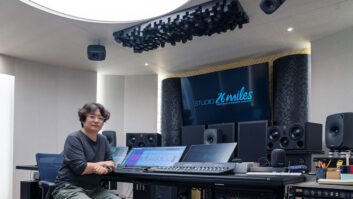In his Continuing Adventures In Software, Rich Tozzoli finds that he relies as well on core hardware tools.
Home Suite Home: Rich Tozzoli’s primary work environment. Today I was working in my studio, composing some TV cues, and I took a moment to just look around. I realized that my setup was crafted over the years!for the way I work, and that it wouldn’t necessarily be as effective for someone else. Commercial studios are setup fairly generically, to get as many people in and out while providing as much high-level gear as possible. But our home setups are where we can customize, modify, experiment and evolve. And that got me thinking about a few of the most valuable pieces of studio hardware that I’ve acquired over the years and how they’ve helped me get the job done countless times.

Here they are, in no particular order:
FOCUSRITE ISA 428 QUAD PREAMPLIFIER:
I’ve got the original version, not the 428MKII with the larger knobs. Wow, if I think about the amount of sessions I’ve used this on…It’s simply four channels of high-quality Focusrite preamp, VU and LED metering, as well as a digital I/O card with optical out. It’s got ADC soft limit, a filter (which I tend not to use), Mic/Line/Instrument inputs (four 1/4-inch DI inputs on the front, XLRs on the rear), and a useful variable impedance capability (which I actually do use). In my studio, it doesn’t live in a rack, as I’m constantly taking it out for mobile or location sessions. No doubt, this is a clean, lean preamp machine.
EVENTIDE H-9 HARMONIZER MULTI-EFFECTS PEDAL:
This is a fairly new addition to my family, but wow, what a powerhouse for guitar, bass and keyboard effect processing. What makes it so cool is the fact that it’s modular and it can!employ any of Eventides’ stompbox sounds—and then some.
Effects can be downloaded into the box via!USB!from Eventide’s website, which means it’s not a fixed deadend piece of hardware, but what I like about it the most is the ability to control it via Bluetooth from my iPad or iPhone. You can, of course, control it from the box itself, but with my iPad on the desktop, I’m able to dial in sounds that would be challenging without it, and save them for future use. Every time I plug into it, I find a new inspiration, and that’s what makes it so valuable to my creativity.
MANLEY MASSIVE PASSIVE EQ:
This bomber costs a nice pile, but wow, is it worth it. Nothing like putting your DAW mix through a few tubes and some metal film resistors, film capacitors and hand-wound inductors. While it’s a four-band EQ, I tend to use mostly mids and lows, which to me are its specialty. While I have the UAD software version and use it, this hardware version resides as an insert on my master fader. There’s nothing like tweaking some great knobs.
GRACE M906 MONITOR CONTROLLER:
This ultra-clean monitor controller easily handles whatever you put into it, from stereo to full 5.1. It’s a bit pricey, but I’ve never regretted the purchase. I feed an optical cable to it from my Pro Tools HDX rig for stereo and 5.1 mixes up to 48 kHz, and an AES3 digital cable for sessions up to 192 kHz. In addition, I run the optical output from my Mac into it, so I can listen to my mixes in iTunes or for general playback, while maintaining the same volume levels as my Pro Tools setup. I simply switch the input on the front, which is one of those simple but effective things that’s great to have in a home studio. The main control unit sits in a rack off to the side, while the remote sits just to my left on the desktop. It’s also a great headphone controller with two reference headphone outputs, one on the remote controller and one on the front panel of the system mainframe.
EARTHWORKS QTC-1 MICROPHONES:
These omni bad boys have recorded probably several hundred sessions. I first started with the TC-30Ks on Al DiMeola sessions (which are not easy), but they had a little too much self noise for me. I moved up to the QTC-1s (now called the QTC-40s); I’ve now owned them for years. They are the kind of mics you plug into a good preamp, place in front of whatever, and get a great sound out of them. I’ve found them especially effective on acoustic guitars and drum overheads. They are flat from 4 Hz to 40 kHz, and are transparent with very little coloration, if any at all. I also have four channels of Earthworks 1024 preamps and when paired with the Earthworks QTC- 1s, it’s quite a potent combo.
NHT PRO M-00 LOUDSPEAKERS AND S-00 SUB:
Purchased many moons ago at the Surround Conference in Beverly Hills, CA, these have been with me a long time. Sure, I use other monitors and enjoy them, but these little bad boys, which they sadly don’t make anymore, have made me a nice living. I actually have several sets of them, which I use for stereo and surround monitoring. I’ve even flown a set with a sub down to my friends’ house/studio in St John USVI and left them there, so every time I go down, I have a piece of my home studio with me.
DOUBLESIGHT DS-90U USB MONITOR:
Yes, this $125 investment has paid dividends greatly. It’s a small 9-inch, USB-powered monitor that I plug into the back of my Mac monitor. It resides just behind my Grace 906 remote, and I use it to watch video when composing to picture. That way, it stays out of the way of my Pro Tools Mix and Edit windows. When not composing to pic, I tend to leave a Waves Dur-rough software meter on the screen all the time. It’s a easy glance to the left to check my levels. Just goes to show you, the best purchases for your studio are not always the most expensive ones!

